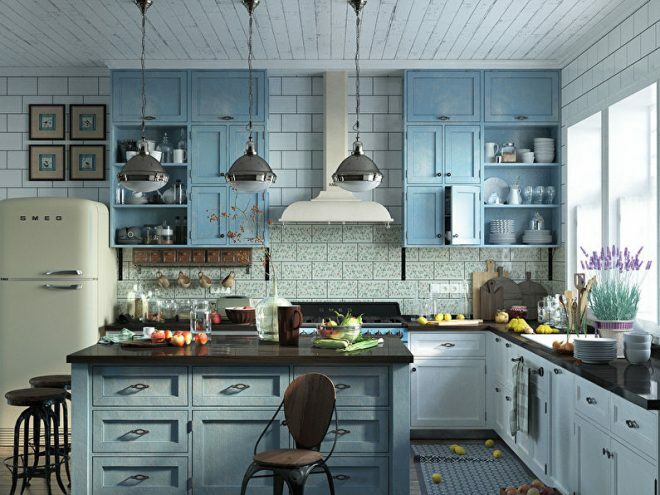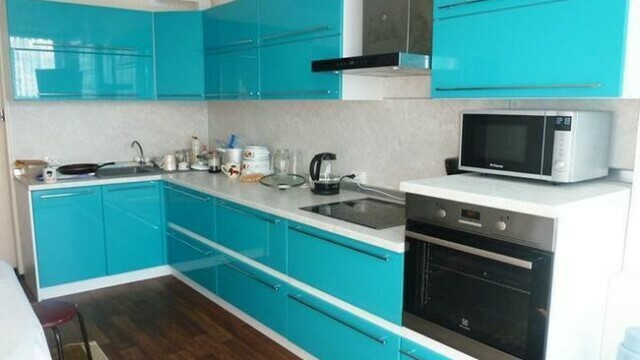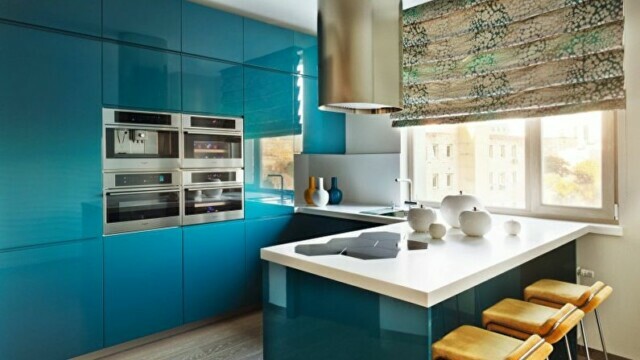The turquoise kitchen in the interior, the photos of which instantly attract attention, is one of the most unique. She always looks bright, but at the same time calm, causing a feeling of peace and relaxation. Have you noticed that even on airplanes, the upholstery is usually blue or turquoise? Psychologists have long noticed that it is this color that soothes in the best way. In general, these are some of the most controversial, but not indifferent, shades. So why not make a kitchen like this?

Turquoise: the influence of color, what to combine with
The name comes from the semi-precious stone of the same name. He is considered a lucky talisman, the owners of which will live their entire lives in abundance. Today this color is suitable for interiors of almost any style and purpose.
Attention! Earned on our website kitchen designer. You can familiarize yourself with it and design your dream kitchen for free! May also come in handy wardrobes designer.
The main advantage of this border color is its dual nature. The base consists of two colors: green and blue. And although the buryuza belongs to a colder palette (blueness of the sky), with the addition of warm shades, it will instantly sparkle with the azure gentle sea or the hot south. This means that each turquoise kitchen in the interior (photo below) turns out to be unique.

Interior styles
Pure turquoise is rare in nature. More often it is represented by a whole spectrum of tones, it has all kinds of blotches and veins. It is quite difficult to repeat such a color in the kitchen, it is more important to emphasize the style of the room in detail, correctly combining texture and materials.
Details have always occupied one of the dominant places in the kitchen. If you hung bright curtains in the room, then it is unlikely that your interior will become turquoise. Some of the surfaces can be of a basic color, plus additional decorative techniques are introduced here (for example, textile accessories: towels, curtains, chair covers, tablecloths). The main thing is that the blue-green gamut should prevail.
Turquoise is also suitable for small kitchens. In a dark room, where the sun's rays rarely peep in, using warm greenish tones will bring the whole space to life.
Provence turquoise kitchen
Fresh turquoise tones are loved by the southern people who are attracted by the coolness. Pastel blue often dominates the interiors of the French countryside. The most favorite shade is heavenly. It is for Provence that a translucent, artfully aged palette is best suited, in which several neighboring shades are combined.
Slightly worn countertops and facades look very elegant, in which turquoise skillfully sets off the wooden bottom. The blueness is well complemented by light wood, linen, stone and burnt clay.
In this style, turquoise is common on wooden surfaces, walls, fabrics (tablecloths and curtains), as well as in cute porcelain and ceramic trinkets. And ceramic tiles in patchwork colors (on the floor, in the apron area) will become an effective and expressive accent of the interior.


Scandinavian style turquoise kitchen
The Scandinavian style came to us from countries with cold climates, Sweden and Norway. In this kingdom of the icy nature of the sun, comfort and warmth are sorely lacking. But it can be added with light woods, ceramics, handmade carpets.
Most often, cloudy and grayish shades of the sky are used. White marble, stainless steel and glossy ceramics go very well with them. Light walls will brighten the reality, and the kitchen will seem more spacious. It is best to paint the wall on the sunny side bright blue.
Bright wall decor will bring the individual handwriting of the owner into the room. In general, point accents are the highlight of this style, but at the same time there should not be a lot of turquoise, as otherwise there is a risk of overloading the interior.

Turquoise kitchen in a modern style
A monochrome turquoise kitchen will hardly fit into a classic interior. But for avant-garde methods, such a typeface is more suitable. If you choose turquoise color in the interior of the kitchen, then black, steel gray and white gloss should complement it.
Modern style does not tolerate excesses, the colors must be clean and uniform, and the surfaces are smooth (durable glass, artificial stone, chrome-plated steel, polished wood). Such facades and countertops take up most of the entire space of the room.
If the turquoise kitchen in your interior is bright and rich, then it is better to soften it a little and use not gloss, but matte paint or semi-gloss satin. Decorate the rest of the surfaces with lighter and more delicate shades.
If there are windows in the kitchen on the sunny side, the turquoise facade of cold tones can refresh and cool the interior. And it will be very pleasant to be in such a room.


Turquoise Art Nouveau kitchen
This minimalist style uses both bright colors and more subdued ones. Modern, loft and high tech best combined with turquoise gloss. Its highlights echo the chrome surfaces of pipes and shelves, fittings. In this rare case, even one turquoise spot will be able to "stretch" the entire interior on itself.
The Art Nouveau style is characterized by rounded corners and flowing lines. If you add gloss here, you get the vibrant colors of the Red Sea or the tropical ocean. Therefore, in the Art Nouveau style, all kinds of marine images, photo prints with fish, waves and shells are often found.
Turquoise looks very good with metal and favorably emphasizes steel appliances. But a countertop or floor made of artificial stone, light wood will also fit into the Art Nouveau style.

Finishes and materials
The texture of the material greatly affects the perception of the turquoise color. Plaster, liquid wallpaper, or reflective paint looks completely different.
Sometimes very large kitchens, for example, combined with a dining room, seem dull. In this case, instead of a monochromatic coating, a cladding with a pattern, a mosaic is used.
The largest palette of turquoise shades is present in enamel paints. They are applied to facades made of MDF and among them you will find even exotic ones, such as the color of thrush eggs, curacao, tiffany, cyan. Not to mention the more common ones - aquamarine, mint, menthol or aqua.

Walls
When decorating walls, a common mistake should be avoided. If you have turquoise countertops, facades and other furniture in your interior, then such a kitchen can hardly be called elegant. This is especially true for saturated colors. The more delicate, light and transparent it is, the more it can be.
There are many options for wall decoration:
- One of the simplest and most efficient ones is considered to be the background coating, with the finishing of all vertical planes.
- You can use two or three shades for walls, floors and ceilings instead of just one. The room will become more spacious.
- Select only one turquoise wall that echoes the facade or apron. But remember that then you need a light headset.
Apron
Swimming pools and bathrooms are often clad in all sorts of shades of blue and green, as they emphasize the element of water. Therefore, in the zone apron (and especially sinks) the natural range will be appropriate, remarkably refreshing the room.
The brightest and most beautiful are the tempered glass aprons with photo printing. You can create almost any design by protecting work surfaces and transforming the most uncomplicated room.

Floor and ceiling
Glossy turquoise surfaces are ideal for the ceiling. This color is associated with the endless sky and the ceiling is quite capable of becoming the center of the room, catching the eye.
Gypsum panels are an inexpensive but rewarding method. If you have high ceilings, then create a two-tiered plasterboard structure. A fragment of the ceiling is painted with water-based acrylic paints. The topmost turquoise part or a rim from it will help raise it in height.
Another good option is a stretch ceiling. Here you have a choice between matte and glossy surfaces. Moreover, the gloss will make the room larger due to the reflection of lighting fixtures.
For a turquoise floor, choose ceramic or linoleum tiles. Installing a "warm floor" system under the ceramic tiles will give you cognitive dissonance. A person, stepping on a cold blue floor, will feel warmth and this, willy-nilly, will attract his attention.
Lighting and kitchen appliances
A turquoise kitchen will look no less attractive in the evening than during the day if you take care of the lighting. Besides LED lamps and small lamps, you can place a large chandelier in the center to match the entire design.
Lighting Features:
- When choosing lamps, you should be especially careful with a white kitchen. The white color sets off the deep turquoise in the best way and the furniture looks incredibly bright (with all the specks).
- There are nuances in planning artificial lighting. If the facade is turquoise and this subtone is present in the wall decoration, then the lamps should be white and neutral.
- Cold blue lighting will make the kitchen uncomfortable.
- With additional yellow lighting, turquoise facades will be distorted and an ugly hue will appear.
With a natural turquoise color, the black technique looks best, since these are the natural shades of this stone. But white and steel electrical appliances are also suitable (especially for a rustic style). The main thing is that the design of the kitchen in turquoise color matches the photo of the best interiors.
Photo: turquoise kitchen in the interior























Prev
Next
average rating 0 / 5. Number of ratings: 0
No ratings yet. Be the first to rate.



